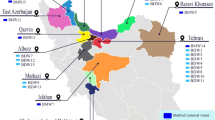Abstract
This paper focuses on a survey of uranium and thorium decay chain radionuclides in food and drinking water from the thorium-rich (monazite-bearing) region of Buena, which is located in the state of Rio de Janeiro, Brazil. The radionuclide concentration values in the food and drinking water from Buena reached values higher than 100-fold the international reference values. The daily intake of radionuclides by the local population is similar to that of another high background radiation area in Brazil, but the intake is higher than that of residents from a normal background radiation area. Approximately 58 % of the food consumed by Buena inhabitants is produced locally. Based on that figure, locally produced food and the dilution of total radionuclides in the diet of residents caused by food importation are both highly relevant to a population’s intake of radionuclides. The concentration values for 210Pb and the radium isotopes in drinking water from Buena are among the highest values to be reported in the literature. 228Ra is the most important radionuclide ingested with both food and water among the inhabitants of Buena.
Similar content being viewed by others
References
Adams JAS (1977) The geological origins of radioactive anomalies. In: International Symposium on Areas of High Natural Radioactivity, Poços de Caldas, Brazil, 16–20 June, pp. 5–14
Amaral ECA, Rochedo ERR, Paretzke HG, Penna-Franca EP (1992) The radiological impact of agricultural activities in an area of high natural radioactivity. Radiat Prot Dosim 45:289–292
Amaral RS, Vasconcelos WE, Borges E, Silveira SV, Mazzili BP (2005) Intake of uranium and radium-226 due to food crops consumption in the phosphate region of Pernanbuco-Brazil. J Environ Radioact 82:383–393
Chabra AS (1966) Ra-226 in food and man in Bombay and Kerala State (India). Br J Radiol 39:141–146
Conti LF (1995) Programa de análise estatística e gráfica de dados, WINGRAF, Instituto de Radioproteção e Dosimetria. IRD/CNEN, Rio de Janeiro
Curie LA (1968) Limits for qualitative detection and quantitative determination. Application to radiochemistry. Anal Chem 40(3):586–593
Fernandes HM, Franklin MR, Veiga HL (1998) Acid rock drainage and radiological environmental impacts. A study case of a uranium mining and milling facilities at Poços deCaldas. Waste Manage 18(3):169–181
Ghiassi-Nejad M, Beitollahi MM, Asefi M, Reza-Nejad F (2003) Exposure to 226Ra from consumption of vegetables in the high level natural radiation area of Ramsar-Iran. J Environ Radioact 66:215–225
Godoy JM (1990) Methods for measuring radium isotopes: gross alpha and beta counting In: Environmental behavior of radium, technical report Series No. 310. IAEA, Vienna, 205–211
Godoy MLDP, Godoy JM, Roldão LA (2001) Determination of trace elements in coal and coal ash samples by ICP-MS. At Spectrosc 22:235–243
Hongda Z (1997) Intakes of food and internal doses by ingestion in two high radiation areas of China. High levels of natural radiation, International Congress Series II36, Excerpta Medica. Elsevier, Amsterdam, pp 149–154
Instituto de Radioproteção e Dosimetria (1996) Manual de Procedimentos Radioquímicos, 3rd edn. IRD, Rio de Janeiro, Brazil
Lalit BY, Shukla VK (1982) Natural radioactivity in foodstuffs from high radioactivity areas Southern India. In: Vora KG, Mishra UC, Pillai KC, Sadasivan S (eds), Natural radiation and environment. Wisley Eastern Limited, Bombay, New Delhi, pp. 43–49
Lauria DC, Godoy JMO (2002) Abnormal high natural radium concentration in surface waters. J Environ Radioact 61(2):27–37
Miller JC and Miller JN (1993) Statistic for analytical chemistry. Limited Edition, Chichester (3rd edn). Ellis Horwood, England, p. 233
Mistry KB, Bharatan KG, Iyengar GAR (1970) Radioactivity in the diet of population of the Kerala coast including monazite bearing high radiation areas. Health Phys 19:535–542
Nuccetelli C, Risica S (2008) Thorium series radionuclides in the environment: measurement, dose assessment and regulation. Appl Radiat Isot 66(11):1657–1660
Paul AC, Pillai PMB, Velayudhan T, Pillai KC (1982) Internal Exposure at high background areas. In: Natural Radiation Environment, Wiley Easten Ltd, Bombay, NewDehli, pp. 50–57
Penna-Franca E (1977) Review of Brazilian investigations in areas of high natural radioactivity. Part II. Internal exposure and cytogenetic surveys. In: International symposium on areas of high natural radioactivity, Poços de Caldas, Brazil, 16–20 June, pp. 29–48
Santos PL, Gouvea RC, Dutra IR, Gouvea VA (1990) Accumulation of 210Po in foodstuffs cultivated in farms around the Brazilian mining and milling facilities on Poços de Caldas Plateau. J Environ Radioact 11:141–149
Santos EE, Lauria DC, Amaral ECS, Rochedo ERR (2002) Daily ingestion of 232Th, 238U, 226Ra, 228Ra and 210Pb in vegetables by inhabitants of Rio de Janeiro City. J Environ Radioact 62:75–86
Simon SL, Ibrahim SA (1990) Biological uptake of radium by terrestrial plants. In: Environmental behavior of radium, technical report Series No. 310. IAEA, Vienna, 545–599
UNSCEAR (2000) Sources and effects of ionizing radiation United Nations Scientific Committee on the effects of atomic radiation. USA, New York
Vianna LT, Tauhata L, Oliveira AE, Oliveira JP, Clain AF, Ferreira ACM (1998) Evaluation of Brazilian intercomparison program data from 1991 to 1995 of radionuclide assays in environmental samples. Appl Radiat Isot 49:1463–1466
WHO (2006) Guidelines for drinking-water quality, radiological aspects. In: http//www.who.int/water_sanitation_health/dwq/gdwq3rev/en/index.html
Acknowledgments
We want to thank the referees for their comments, which led to many improvements in the paper. This research was partially supported by the Brazilian Financiadora de Estudos e Projetos-FINEP. We are very grateful to Maria Lucia Polônio for her assistance in diet issues; to all staff of the Environmental Sample Analysis Service of IRD for most of radionuclide determinations in foodstuffs; to Sheila M. Nascimento for the water radiochemical analysis; and to Laercio L. de Carvalho for his support during the water sampling. We also wish to thank the inhabitants of Buena.
Author information
Authors and Affiliations
Corresponding author
Rights and permissions
About this article
Cite this article
da Costa Lauria, D., Rochedo, E.R.R., Godoy, M.L.D.P. et al. Naturally occurring radionuclides in food and drinking water from a thorium-rich area. Radiat Environ Biophys 51, 367–374 (2012). https://doi.org/10.1007/s00411-012-0428-7
Received:
Accepted:
Published:
Issue Date:
DOI: https://doi.org/10.1007/s00411-012-0428-7




